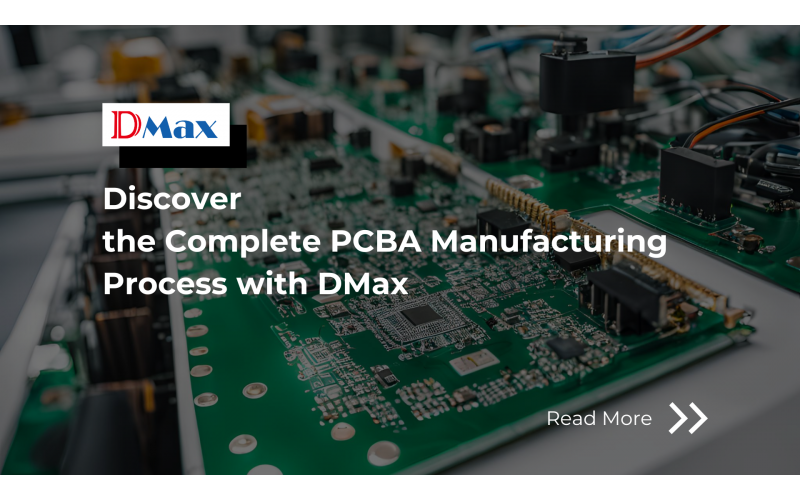Table of Content:
Client-Provided Design Phase
Prototyping for Long-Term Partners
Material Procurement
PCB Fabrication
Solder Paste Application
Pick and Place
Reflow Soldering
Inspection and Quality Control
Through-Hole Component Insertion
Final Assembly and Testing
Introduction
Printed Circuit Board Assembly (PCBA) is a critical process in the electronics manufacturing industry, transforming a simple circuit design into a functional electronic device. Understanding the PCBA manufacturing process helps in appreciating the complexity and precision involved. In this article, DMax will take you through the detailed steps of the PCBA manufacturing process, from initial design to the finished product.
1. Client-Provided Design Phase
Typically, clients provide their detailed schematic and layout design of the PCB before placing an order. This design phase involves creating a comprehensive blueprint that meets all specifications and standards. Key considerations during this phase include component placement, trace routing, and power distribution.
2. Prototyping for Long-Term Partners
While many clients handle prototyping independently, DMax offers prototyping services for long-term partners. This step involves fabricating a small batch of the PCB to test its functionality, helping identify and correct any design flaws before mass production.
3. Material Procurement
With a validated prototype (or client-provided design), the next step is to procure the necessary materials and components. This includes the PCB substrate, solder paste, electronic components, and any other materials required for assembly. DMax ensures high-quality materials, such as FR4 PCB, aluminum PCB, and polyimide PCB, are used for the overall reliability and performance of the final product.
4. PCB Fabrication
The PCB fabrication process starts with selecting the appropriate base material, usually FR4 PCB for its excellent balance of cost and performance. The design is transferred onto the PCB material using a photographic process, followed by etching to remove excess copper, leaving only the desired circuit traces. Drilling holes for component leads and vias, and applying a solder mask to protect the traces, are also part of this phase at DMax.
5. Solder Paste Application
Solder paste, a mixture of powdered solder and flux, is applied to the PCB using a stencil printer. The paste is deposited on the pads where the components will be placed. This step is critical for ensuring proper electrical connections and mechanical stability.
6. Pick and Place
In the pick and place process, automated machines place surface mount components (SMCs) onto the solder-pasted PCB with high precision. These machines are programmed to position each component accurately according to the design specifications.
7. Reflow Soldering
After the components are placed, the PCB is subjected to a reflow oven.
The heat causes the solder paste to melt and form solder joints between the components and the PCB pads. The controlled cooling process solidifies the joints, securing the components in place.
8. Inspection and Quality Control
Quality control is integral at every stage of PCBA manufacturing. Automated Optical Inspection (AOI) systems are used to check for soldering defects, component placement accuracy, and other potential issues. For more critical applications, DMax employs X-ray inspection to detect hidden solder joint defects.
9. Through-Hole Component Insertion
For PCBs that require through-hole components, this step involves inserting components with leads through pre-drilled holes. The leads are then soldered to pads on the opposite side of the PCB, usually through wave soldering or selective soldering processes.
10. Final Assembly and Testing
The final assembly involves integrating the assembled PCB with other components such as connectors, heatsinks, and enclosures. The completed unit undergoes functional testing to ensure it operates as intended. Tests may include electrical tests, thermal cycling, and performance evaluations.
The PCBA manufacturing process is a complex and meticulous procedure that transforms a circuit design into a functional electronic device. Each step, from material procurement to final testing, is crucial for ensuring the quality and reliability of the final product. Understanding this process not only highlights the precision involved but also underscores the importance of working with a reputable PCBA manufacturer like DMax.
By choosing DMax, a manufacturer that emphasizes quality control, uses advanced technology, and has a deep understanding of the entire PCBA process, you can ensure the success of your electronic products.

